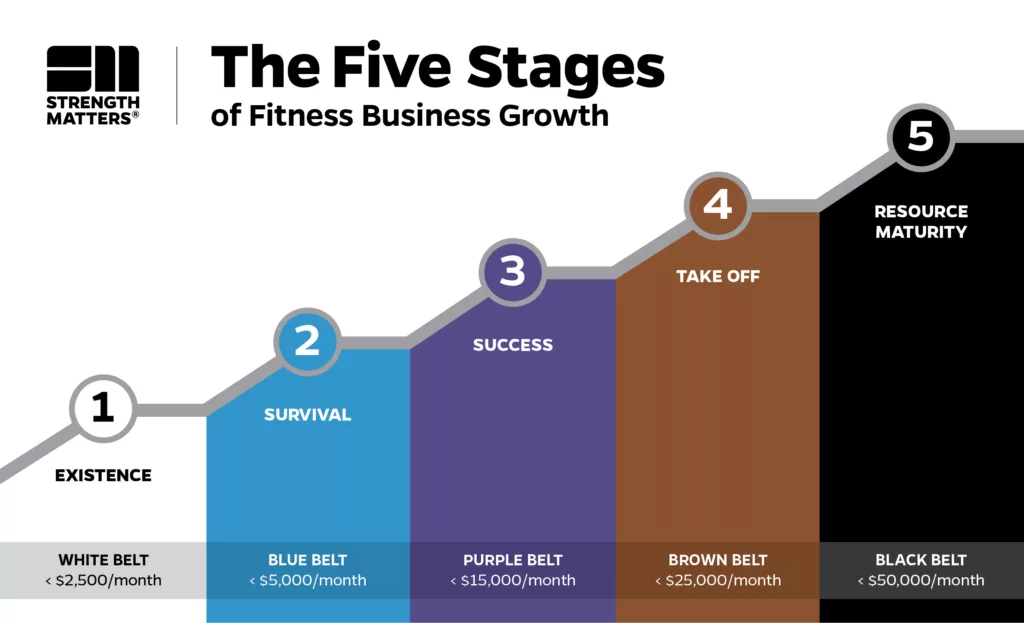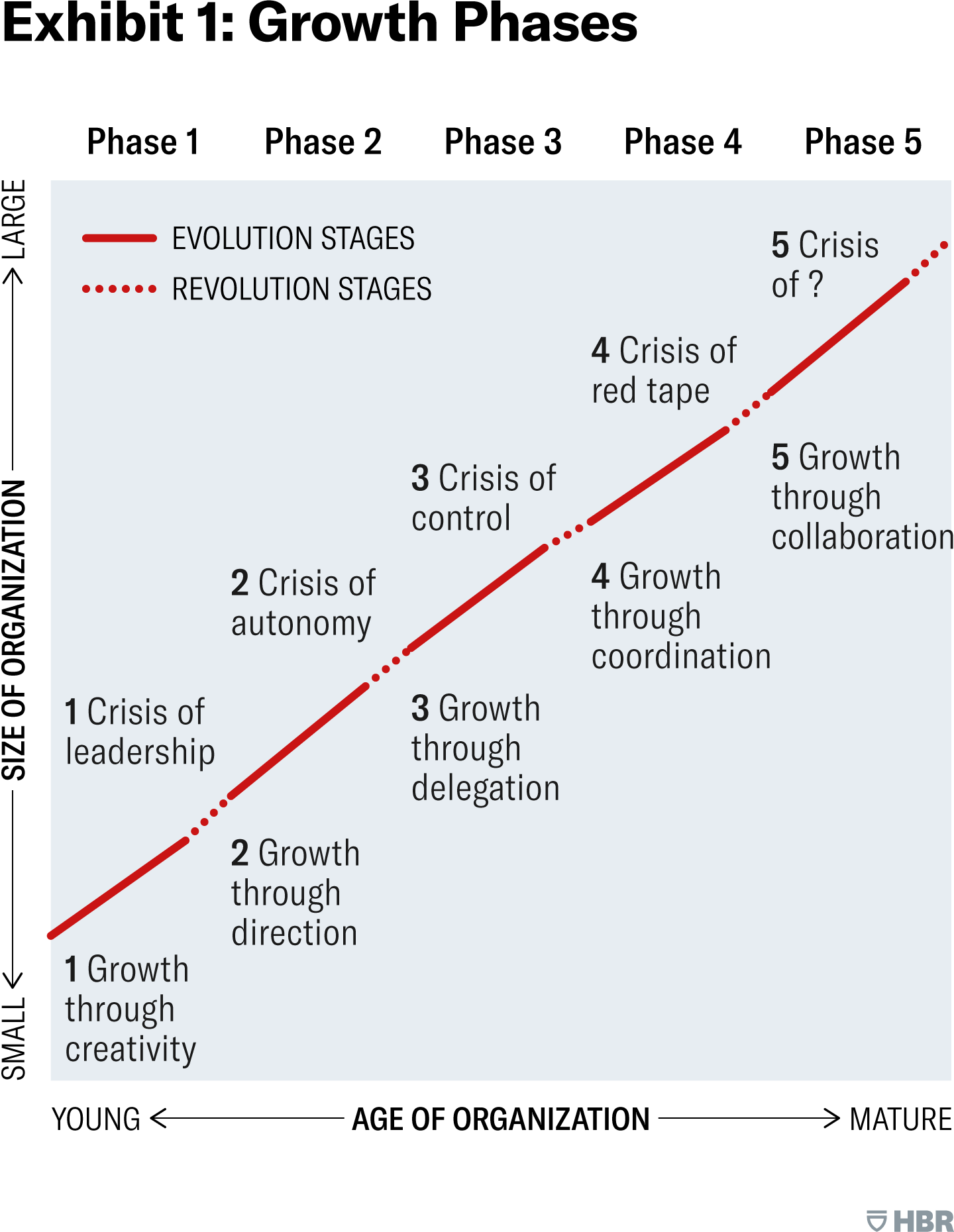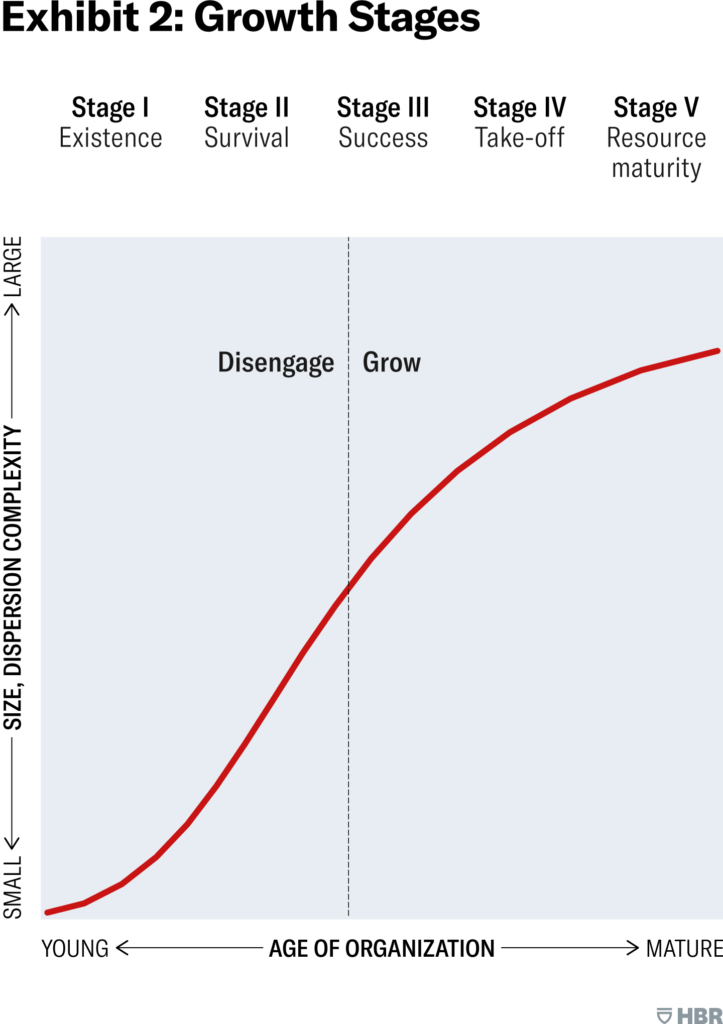*Note, If you haven’t read Chapter 1: How to Professionalize Your Fitness Business in Just 5 Steps or Chapter 2: Introducing the Black Belt Fitness Business Growth System we advise doing so first.
I want to introduce to you the Five Stages of Fitness Business Growth, but before we do that, I want you to imagine yourself white-water rafting: you start in calm waters, but you know that ahead lie the rapids, requiring strategic navigation and a dash of daring.
Growing your fitness business is much like this exhilarating journey, navigating through the serene start-up phase, battling through the challenging rapids, and ultimately emerging victorious on the other side.

Table of Contents
Introduction
Have you ever read the “Five Stages of Small-Business Growth” by Neil Churchill and Virginia Lewis? Don’t worry if you haven’t. It’s a practical strategy introduced in the Harvard Business Review, systematizing growth patterns and challenges faced by small businesses into a digestible format, even when it might seem like an insurmountable task at first glance.

In our Black Belt Business Academy, this Harvard-analyzed approach serves as a blueprint. It anticipates and mitigates challenges on the sometimes-turbulent river of fitness business growth.
The Black Belt Business System isn’t just practical. It’s a methodology deeply rooted in proven strategic frameworks, combining both theory and practice to sail through each stage of business growth with steadfast confidence and a methodical approach.
Crafted for fitness business owners like yourself, it provides a practical, systematic, and personalized roadmap to navigate through the unpredictable currents of entrepreneurship. Each ‘belt’ or chapter does more than mark a stage of your financial and operational progression. It’s a benchmark of the in-depth, quality service you extend to each client you bring on board.

Curious about the five stages of fitness business growth? Let’s dive into our system that weaves academic theory and pragmatic application into a robust navigational guide, steering your fitness business toward a future where success isn’t merely achieved but is ethically, sustainably, and vigorously upheld for the well-being of those we aim to serve.
Stage I: Existence (White Belt < $2,500/month)

This is the first exciting leg of your business adventure: the White Belt stage, also known as the “Existence.” Picture this phase like those serene waters where your raft gently bobs – it’s calm, but you’re gathering your strength and wisdom for the rapids ahead.
This isn’t merely about staying afloat; it’s about meticulously setting a strong foundation, which ensures not just immediate steadiness but also paves a steadfast path towards future growth.
- Financial Stability: In the fitness industry, continuous learning and adaptation are key. But first things first, we need to make sure your financial footing is rock-solid. You need to prioritize getting your first initial clients and ensuring a regular income flow crafts the financial cornerstone that will underpin all future expansions and learning.
Think About This: Your number one priority is getting your first 10 clients. Don’t worry about anything else until you achieve this.
- Service Excellence: Your initial clients are your first fans! Imagine them as your cheerleaders on the riverbank. Just like nailing the basics in martial arts, your unwavering dedication to client satisfaction is paramount during this stage. It not only builds loyalty but also sparks precious word-of-mouth referrals, which are crucial for expanding your client family.
Quick Tip: A simple follow-up message on days when your clients aren’t training can make them feel valued and appreciated!
- Client Expansion: As you build your client raft, it’s not just about inviting new passengers aboard but also ensuring everyone stays happily seated. Balancing the attraction of new clients with the retention of your existing ones constructs a community that enables stable client and revenue growth.
Ask Yourself: How can you add an extra touch to ensure your existing clients feel continually valued?
- Financial Smarts: Much like a martial artist’s steady gaze, keeping a keen eye on your financial and operational aspects is vital to smoothly sail through the challenges, ensuring your venture stays buoyant during the start-up phase.
Quick Tip: Start saving immediately. Put 20% of your earnings away every month to prepare you for the upcoming rapids.
The Race to Blue Belt: Your Secret Weapon for Long-Term Success
Gaining mastery over the foundational elements during the White Belt stage is not merely a passive accomplishment but a strategically sprung board, catapulting your business voyage straight into the Blue Belt stage — a realm where genuine growth begins to unfurl.
Quick, yet adept transition is our mantra here, and it’s not about circumventing crucial learnings but embedding strategies so impeccably that your springboard to Blue Belt becomes both smooth and notably rapid.
Here’s the breakdown of why hitting the accelerator towards the next stage is critical:
- Bolstering Early Growth: Transitioning to the Blue Belt isn’t just a move; it’s a dynamic leap from mere survival, heralding an era where your business pivots from merely “being” to tangible, metric-driven growth.
- Fortress Against Vulnerabilities: Swift navigation to Stage 2 isn’t hasty; it’s strategic, curbing vulnerabilities such as erratic cash flows and operational teething issues, building a fortress around your new venture.
- Endorsing Sustainable Practices: Stepping into the Blue Belt isn’t just progression; it’s an endorsement, a tangible stamp affirming that your foundational strategies aren’t just theories but practicable, sustainable pathways catapulting you towards successive, ethical growth.
In essence, powering through to the Blue Belt isn’t just a transition – it’s an accelerated advancement, meticulously strategized to safeguard against initial-stage vulnerabilities while asserting a sustainable, growth-oriented trajectory for your fitness business.
Swift, yet secure progression ensures not only the solidification of your business’s foundational aspects but also sets a vigorous pace, leading towards a future woven with robust growth and strategic sustainability.
The key is speed and strategy, and let them be the twin engines propelling your business forward, steadfast and sure, into the seas of success.
Key Takeaways:
- Rock-Solid Foundation: Make sure your financial, operational, and client-service aspects are unshakeable, providing a sturdy platform for your business.
- Dynamic Progression: Harness the stability and strategies developed during the White Belt stage to fuel a robust and agile move into the Blue Belt, transitioning your business from mere survival to initiating growth.
- Money Matters First: Always keep financial stability in the spotlight, creating a resilient financial bedrock that champions and propels future growth.
If you apply this strategy at White Belt, your fitness business will not only navigate the initial, challenging waves but also be deftly poised to ride the upcoming waves of growth and success.
Transitioning from the White Belt to the Blue Belt signifies a crucial jump towards sustainable success, with financial stability acting as the linchpin in establishing a resilient foundation that nurtures future growth and learning.
Stage II: Survival (Blue Belt < $5,000/month)

Discipline is key in the Survival stage, where you, the fitness professional, embody the strategic and resilient nature of a Blue Belt, weaving threads of stability and gradual growth into your blossoming business.
- Shielding Your Financial Base: The Defensive Tactics of a Blue Belt
Like a martial artist in defense, ensure your business consistently generates enough immediate cash flow to tackle essential expenditures, safeguarding an uninterrupted operation. - Sculpting Sustainable and Distinctive Service Offerings: A Methodical Approach
Focus on refining your services. Ensure even as a sole trador, your business can sustain adequate cash flow to support growth and return without compromising quality or client satisfaction.
At this juncture, while your business structure may still be simple, your role extends beyond delivering services. It demands shrewd financial management and critical business decisions to harmonize stability and envisage gradual growth.
Your planning should pivot on fundamental cash management and forecasting while maintaining a symbiotic relationship between the owner and the business.
The potential pathways diverge here: your fitness business might scale in size and profitability, progressing to Stage III, or it might remain in the Survival Stage, yielding marginal returns on time and capital.
The latter scenario prevails until the adoption of a more fortified financial model or an eventual shift occurs due to retirement or a career transition.
This stage transcends mere survival, carving a trajectory that propels the fitness business not just to stay afloat but to gradually ascend toward profitability, thus paving the path toward the next stage of the journey.
Key Takeaways:
- Immediate Financial Safeguarding:
- Ensure a stable immediate cash flow to cover crucial expenditures.
- Sustainable Marketing Strategies:
- Develop unique and honed marketing stratagies that assure steady cash flow and economic sustainability.
- Beyond Mere Survival – Growth and Profit Strategy:
- Aspire not just to preserve but to cultivate a pathway towards steady growth and profitability.
Your Adaptive Strategy as a Blue Belt:
Channeling the adaptive strategies and resilience of a Blue Belt, this stage intertwines crucial immediate financial stability with a vision for sustainable growth.
Navigate through the competitive fitness market, formulating a trajectory that not only ensures survival but also cultivates growth and profitability, progressively building toward the next chapter in your business journey.
By embedding actionable and relatable strategies within this stage, your journey from Survival to Growth becomes a well-charted path, powered by the strategic lights of financial management and client-centric service refinement, providing not just a survival strategy but a roadmap to sustainable growth and profitability.
Stage III: Success (Purple Belt < $15,000/month)

Navigating the ‘Whitewater’ Rapids of Fitness Business Growth
As you venture into the intriguing Purple Belt stage, your fitness business is successful yet simultaneously faces the turbulent waves of the ‘Whitewater’ phase. This is where your journey delicately balances between exhilarating success and the potential perils of rapid flow.
At this stage, your business is plunged into a sea of challenges: maintaining high-quality services amidst management intricacies, ensuring effective team coordination, and steering through market vicissitudes.
Navigating these waters demands strategic paddling: making decisive choices between pursuing relentless waves for growth or choosing a calm stream that allows for steady, assured progression.
You essentially must make a choice. Do you either go for:
- Stability in Calm Waters (Substage III-D): While you enjoy a steady market presence and consistent profitability, akin to a martial artist content with their Purple Belt, this path, although seemingly calm, demands strategic hires. Additional staff may be needed to manage tasks, but the primary goal subtly shifts towards prudent financial management. It’s not about sailing faster, but ensuring the boat remains steady, preserving its course through wisely managed resources and fund conservation.
- Braving the Rapids for Growth (Substage III-G): Alternatively, imagine amplifying your services, possibly opening another fitness studio and being that martial artist eyeing the next rank. This pathway craves strategic and exhaustive planning and active participation in all business aspects. It’s about skillfully maneuvering through the choppy waters, ensuring that the rapid growth doesn’t capsize your venture.
Key Takeaways:
- Strategic Choice-Making: Identify whether your business needs to sail through the calm waters of steady success (III-D) or brave the rapid waves for accelerated growth (III-G).
- Team Development and Systems: Implement systems and strategically recruit to facilitate either stable operation or expansion, depending on your chosen path.
- Financial Management: Ensure your business remains buoyant through prudent financial practices, maintaining profitability, and adept budget management.
Example Pathways:
Substage III-D: Maintaining Steady Sails
The goal here is to conserve and strategically utilize resources, hire other trainers, and admin staff, and ensure basic systems are in place to weather potential future storms. The business owner may choose to step back slightly but needs to maintain strategic oversight to safeguard stability.
Substage III-G: Riding the Growth Wave
Here, the business owner channels the financial influx into expansion, anticipating and planning for future growth needs. Active participation and detailed attention to strategic planning is imperative to skillfully navigate through tumultuous waters without jeopardizing the business.
Purple Belt Summary:
Your journey through the ‘Whitewater’ stage is punctuated by critical decisions, potentially oscillating between the calm of stable prosperity and the tumultuous waves of aggressive growth.
Your choices here will not only sculpt the present condition of your fitness business but also direct its future trajectory, influencing subsequent adventures and potential endeavors in business development or alternative paths.
Whether you choose to smoothly sail through stable streams or daringly ride the growth rapids, remember: your strategic choices, prudent financial management, and adaptative strategies will be the wind in your sails, propelling you through the ‘Whitewater’ towards your desired destination.
Stage IV: Take Off (Brown Belt <$25,000/month)

Navigating through the pivotal journey to achieve a Brown Belt in martial arts, an individual showcases a compelling blend of mastered techniques and anticipation of ascending to advanced levels.
Similarly, when your fitness business gracefully glides into Stage IV, it teeters on the pinnacle of aspiring achievements, necessitating an amalgamation of strategic delegation, astute financial management, and organizational refinement to steer through the forthcoming “Exciting Times.”
The Art and Nuances of Delegation
Imagine a Brown Belt, diligently refining established techniques while casting a thoughtful eye toward acquiring advanced skills. In this stage, the art of delegation transcends mere task allocation.
It involves entrusting team members with authentic responsibilities, coupled with erecting a framework of checks and balances. But how do you ensure empowerment without inadvertently sliding into a realm of micromanagement? The key lies in entrusting autonomy while preserving an undercurrent of structured guidance.
Financial Finesse: Managing Cash Flow and Investments
A martial artist perpetually balances safeguarding foundational techniques while embracing new, advanced techniques. Similarly, the health of your business hinges on meticulous financial stewardship.
Managing cash flow, strategically channeling investments into growth avenues, and maintaining a harmonious debt-equity ratio not only fortifies against overreach but also poises the business to astutely navigate through opportunities, all without jeopardizing stability.
But what might this careful navigation look like in tangible terms? Consider crafting a financial roadmap, plotting anticipated expenditures against projected incomes, and identifying potential investment avenues and their anticipated ROI.
Organizational Maturity: Specialization and Decentralization
Brown Belts often begin to mentor new students while continually honing their skills. Likewise, as your business morphs, specializing and decentralizing business operations becomes imperative. You essentially begin to strategically fire yourself from the business.
Operational planning and strategic foresight must go hand in hand, with the owner’s involvement pivotal in maintaining alignment across the organization. But how does this organizational shift materialize?
It might mean making sure every department knows its duties, creating ways for departments to talk to each other, and setting a main goal that affects every part of the business.
Exploring Different Options
As a Brown Belt stage, your business is at a crucial point where being skilled meets new growth and challenges. Handling money and management issues well could turn your business into a big company or lead to a profitable sale if done right.
However, there are risks. The journey may hit problems if the owner, possibly becoming too confident, rushes to grow too fast or struggles with handing over tasks, which may sometimes force a step back to a smaller size or an earlier phase.
Key Takeaways
- Lead by Delegating: Give team members real responsibility, helping them grow within a guided framework.
- Handle Finances Wisely: Be smart with money, investing strategically and protecting cash flow to support steady growth.
- Grow the Organization: Develop a specialized, decentralized business, with the owner actively ensuring strategic alignment.
- Navigate Opportunities Carefully: The owner should carefully guide the business through potential growth, scaling, or exiting, while avoiding overconfidence.
- Choose the Right Path: Smartly navigating through potential business directions will shape the company’s path and success.
Moving through the Brown Belt stage requires managing current challenges while also planning ahead. Your journey will not only shape your fitness business now but also define its future journey in the business world, linking current expertise with future goals.
Stage V: Resource Maturity (Black Belt < $50,000/month)

At Stage V, your fitness business advances into the esteemed phase of Resource Maturity, comparable to achieving the respected Black Belt in martial arts—a symbol of mastery, autonomy, and the establishment of a self-sustaining entity. It represents a transformative journey from personal endeavor to widespread impact.
Achieving Financial and Operational Balance
In this peak stage, your fitness business should strive to find a balance between financial stability and operational autonomy, similar to a Black Belt’s balance between technique and intuition. The goal here is not merely to accumulate financial gains but to use them wisely in creating a business that stands strong, even without your constant oversight. It involves smartly utilizing financial and managerial resources to build a structure that can sustain itself while ensuring stability and continuity.
Keeping the Entrepreneurial Flame Alive
Even as your business matures and allows you the freedom to explore various business options, backed by financial and operational strength, it’s crucial to keep the unwavering spirit of entrepreneurship alive.
Like a Black Belt’s dedication to continuous improvement, the heartbeat of the business must be an unrelenting entrepreneurial spirit. This means a commitment to ongoing innovation, enriching client experiences, and stellar service, even amidst established stability and growth.
Building Stability and Legacy
Armed with scale, financial power, and expertise, your fitness business, akin to a wise Black Belt, becomes a symbol of skill and knowledge. The challenge lies in maintaining its robust state while also plotting out a legacy that outlives your active involvement. It means creating something that continues to influence health and wellness even without your direct influence.
Avoiding Complacency through Continuous Evolution
A Black Belt represents a journey of ongoing evolution rather than a final destination. Similarly, while your mature business basks in success, it must avoid the slow creep of stagnation by nurturing a culture of continual refinement and taking calculated innovative risks. Ensuring that the flame of excellence burns eternally involves consistently refining methodologies and exploring new strategies.
Key Takeaways
- Balanced Management: Invest financial gains in building a stable, self-sustaining business.
- Maintain Entrepreneurial Zeal: Even amid stability, uphold a strong commitment to innovation and client-focused service.
- Build a Legacy: Develop strategies that not only solidify your current standing but also plant seeds for a lasting legacy.
- Avoid Stagnation: Promote a culture of ongoing evolution and strategic innovation to consistently enhance and expand impact.
As you navigate through the Black Belt stage, the journey is about continuous elevation—solidifying financial and operational stability, nurturing an unstoppable entrepreneurial spirit, envisioning a scalable legacy, and diligently warding off complacency. This defines the stature and everlasting impact of your fitness business in the industry.
Final Thoughts

Launching and nurturing a fitness business goes beyond passion, demanding a sound, tried-and-true system to ensure a journey toward enduring success.
The Black Belt Business System framework employed here weaves the symbolic progress represented by martial arts belts with Harvard’s small business growth stages, providing a clear and adaptable roadmap.
It delineates various business stages, shedding light on likely challenges and potential strategic actions.
Neglecting to utilize a systematic method can thrust fitness business owners into a tumultuous ocean of unforeseen challenges, risks of financial instability, and potential organizational chaos.
A lack of foresight or using sporadic strategies not only heightens the risk of mismanagement but may also carve a path toward business failure.
Applying a well-thought-out framework not only clarifies the journey ahead but also ingrains steadfast contingency plans, building a resilient, sustainable foundation.
This ensures businesses are not just growth-oriented but also primed for innovation and agility amidst a continuously changing market environment.
Charting a path from the enthusiastic “White Belt” existence stage through the disciplined and cautious “Blue Belt” survival stage, moving forward to the choice-filled “Purple Belt” success or “Whitewater” stage, advancing into the “Brown Belt” Take-Off stage, and culminating at the autonomous, expertise-rich “Black Belt” maturity stage, we weave the narratives of martial artists and business owners together.
Both tales encompass continuous evolution, face them with crucial choices, and encourage the development of a fusion of stability and innovation.
This strategic journey demands maintaining a balance between solidness and innovation, where insights from each stage navigate toward strategic progression and the meticulous development of a legacy that reverberates through time.
Essentially, this combined model materializes not just as a guide but as a steadfast companion through varied business growth landscapes, underscoring mastery, strategic progression, and legacy creation, with the ambition to inscribe a lasting imprint on the wellness industry.
Next Up in the Series – White Belt
Gasping for Cash, Finding Your Niche and Laying the Foundations
FAQ
What Are the 5 Stages of Growth in a Business?
The 5 stages of growth in a business, as defined by Churchill and Lewis in their growth model, are: 1. Existence 2. Survival 3. Success 4. Take-off and 5. Resource Maturity. Each stage presents unique challenges and requires different strategies for the business to navigate through it successfully.
How Do I Grow My Fitness Business?
Growing a fitness business involves navigating through various stages of development, often likened to martial arts belts for symbolic representation. Beginning from ‘White Belt’ or the infancy stage, a business owner should focus on obtaining customers and delivering services, moving through to the ‘Black Belt’ or maturity stage, where the business should be able to stand autonomously, showcasing mastery and creating a lasting, impactful legacy. Each stage demands specific strategies, involving aspects like financial management, delegation, strategic planning, and organizational evolution, tailored to the unique challenges and opportunities presented.
What Is the Business Growth Model of Churchill and Lewis?
The business growth model of Churchill and Lewis outlines 5 stages of growth for businesses: 1. Existence, 2. Survival, 3. Success, 4. Take-off, and 5. Resource Maturity. Each stage represents a different set of challenges, focus areas, and organizational structures, ranging from the initial start-up phase through to maturity. The model provides a framework for entrepreneurs to anticipate challenges, manage current issues, and plan strategies for each stage of business development.
What Are the Levels of Business Growth?
The levels of business growth can be demarcated into various stages, commonly identified as: 1. Existence: The business focuses on acquiring customers and delivering services. 2. Survival: The business aims to achieve a stable customer base and financial standing. 3. Success: The business encounters a decision to expand or maintain current operational levels. 4. Take-off: The business focuses on growth and delegation, and 5. Resource Maturity: The business aims for sustainability, ensuring stability while avoiding stagnation by perpetually evolving and refining strategies. Each level presents distinctive challenges, requiring tailored strategies and approaches for successful navigation and progression to the next stage.
What Are the Levels of Fitness Business Growth?
The levels of fitness business growth are metaphorically likened to the martial arts belt system, each reflecting a specific stage in Harvard’s small business stages:
White Belt/Existence: This initial stage is about acquiring customers and delivering services, with a primary focus on customer satisfaction and basic survival.
Blue Belt/Survival: At this level, the focus shifts to achieving a consistent cash flow and financial stability, ensuring the business can sustain its operations in the longer term.
Purple Belt/Success: Here, the business owner needs to decide whether to exploit the company’s accomplishments and expand or keep the status quo, with each path demanding unique strategies and operational structures.
Brown Belt/Take-Off: In this phase, the main objective is managing rapid growth without losing control, skillfully balancing financial management, and organizational structure.
Black Belt/Resource Maturity: At this mature stage, the business seeks to perpetuate its success, consolidate its gains, and ensure sustainable operation, potentially branching into new arenas or diversifying its offerings.
Each level represents a specific phase in the business growth journey, presenting its unique challenges and requiring specialized strategies for effective progression.

